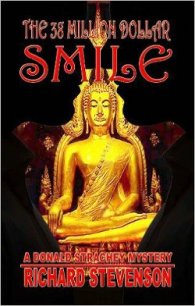Congo - Crichton Michael (книги регистрация онлайн бесплатно .TXT) 📗
In fact, the nature of the imagery remained mysterious to the Project Amy staff. By late April, 1979, they had concluded that her dreams could be explained in four ways. In order of seriousness, they were:
1. The dreams are an attempt to rationalize events in her daily life. This was the usual explanation of (human) dreams, but the staff doubted that it applied in Amy’s case.
2. The dreams are a transitional adolescent manifestation.
At seven years of age, Amy was a gorilla teenager, and for nearly a year she had shown many typical teenage traits, including rages and sulks, fussiness about her appearance, a new interest in the opposite sex.
3. The dreams are a species-specific phenomenon. It was possible that all gorillas had disturbing dreams, and that in the wild the resultant stresses were handled in some fashion by the behavior of the group. Although gorillas had been studied in the wild for the past twenty years, there was no evidence for this.
4. The dreams are the first sign of incipient dementia. This was the most feared possibility. To train an ape effectively, one had to begin with an infant; as the years progressed, researchers waited to see if their animal would grow up to be bright or stupid, recalcitrant or pliable, healthy or sickly. The health of apes was a constant worry; many programs collapsed after years of effort and expense when the apes died of physical or mental illness. Timothy, an Atlanta chimp, became psychotic in 1976 and committed suicide by coprophagia, choking to death on his own feces. Maurice, a Chicago orang, became intensely neurotic, developing phobias that halted work in 1977. For better or worse, the very intelligence that made apes worthwhile subjects for study also made them as unstable as human beings.
But the Project Amy staff was unable to make further progress. In May, 1979, they made what turned out to be a momentous decision: they decided to publish Amy’s drawings, and submitted her images to the Journal of Behavioral Sciences.
2. Breakthrough
“DREAM BEHAVIOR IN A MOUNTAIN GORILLA” WAS
never published. The paper was routinely forwarded to three scientists on the editorial board for review, and one copy somehow (it is still unclear just how) fell into the hands of the Primate Preservation Agency, a New York group formed in 1975 to prevent the “unwarranted and illegitimate exploitation of intelligent primates in unnecessary laboratory research.” *
On June 3, the PPA began picketing the Zoology Department at Berkeley, and calling for the “release” of Amy. Most of the demonstrators were women, and several young children were present; videotapes of an eight-year-old boy holding a placard with Amy’s photograph and shouting “Free Amy! Free Amy!” appeared on local television news.
In a tactical error, the Project Amy staff elected to ignore the protests except for a brief press release stating that the PPA was “misinformed.” The release went out under the Berkeley Information Office letterhead.
On June 5, the PPA released comments on Professor Elliot's work from other primatologists around the country. (Many later denied the comments or claimed they were misquoted.) Dr. Wayne Turman, of the University of Oklahoma at Norman, was quoted as saying that Elliot’s work was “fanciful and unethical.” Dr. Felicity Hammond, of the Yerkes Primate Research Center in Atlanta, said that “neither Elliot nor his research is of the first rank.” Dr. Richard Aronson at the University of Chicago called the research “clearly fascist in nature.”
None of these scientists had read Elliot’s paper before commenting; but the damage, particularly from Aronson, was incalculable. On June 8, Eleanor Vries, the spokesperson for the PPA, referred to the “criminal research of Dr. Elliot and his Nazi staff”; she claimed Elliot’s research caused Amy to have nightmares, and that Amy was being subjected to torture, drugs, and electroshock treatments.
Belatedly, on June 10, the Project Amy staff prepared a lengthy press release, explaining their position in detail and
*The Following account of Elliot's persecution draws heavily on J. A. Peebles, “Infringement of Academic Freedom by Press Innuendo and Hearsay: The Experience of Dr. Peter Elliot,” in the Journal of Academic Law and Psychiatry 52. no. 12 (1979): 19-38.
referring to the unpublished paper. But the University Information Office was now “too busy” to issue the release.
On June 11, the Berkeley faculty scheduled a meeting to consider “issues of ethical conduct” within the university. Eleanor Vries announced that the PPA had hired the noted San Francisco attorney Melvin Bell “to free Amy from subjugation.” Bell’s office was not available for comment.
On the same day, the Project Amy staff had a sudden, unexpected breakthrough in their understanding of Amy’s dreams.
Through all the publicity and commotion, the group had continued to work daily with Amy, and her continued distress-and flaring temper tantrums-was a constant reminder that they had not solved the initial problem. They persisted in their search for clues, although when the break finally came, it happened almost by accident.
Sarah Johnson, a research assistant, was checking prehistoric archaeological sites in the Congo, on the unlikely chance that Amy might have seen such a site (“old buildings in the jungle”) in her infancy, before she was brought to the Minneapolis zoo. Johnson quickly discovered the pertinent facts about the Congo: the region had not been explored by Western observers until a hundred years ago; in recent times, hostile tribes and civil war had made scientific inquiry hazardous; and finally, the moist jungle environment did not lend itself to artifact preservation.
This meant remarkably little was known about Congolese prehistory, and Johnson completed her research in a few hours. But she was reluctant to return so quickly from her assignment, so she stayed on, looking at other books in the anthropology library-ethnographies, histories, early accounts. The earliest visitors to the interior of the Congo were Arab slave traders and Portuguese merchants, and several had written accounts of their travels. Because Johnson could read neither Arabic nor Portuguese, she just looked at the plates.
And then she saw a picture that, she said, “sent a chill up my spine.”
It was a Portuguese engraving originally dated 1642 and reprinted in an 1842 volume. The ink was yellowing on frayed brittle paper, but clearly visible was a ruined city in the jungle, overgrown with creeper vines and giant ferns. The doors and windows were constructed with semicircular arches, exactly as Amy had drawn them.
“It was,” Elliot said later, “the kind of opportunity that comes to a researcher once in his lifetime-if he’s lucky. Of course we knew nothing about the picture; the caption was written in flowing script and included a word that looked like ‘Zinj,’ and the date 1642. We immediately hired translators skilled in archaic Arabic and seventeenth-century Portuguese, but that wasn’t the point. The point was we had a chance to verify a major theoretical question. Amy’s pictures seemed to be a clear case of specific genetic memory.”
Genetic memory was first proposed by Marais in 1911, and it has been vigorously debated ever since. In its simplest form, the theory proposed that the mechanism of genetic inheritance, which governed the transmission of all physical traits, was not limited to physical traits alone. Behavior was clearly genetically determined in lower animals, which were born with complex behavior that did not have to be learned. But higher animals had more flexible behavior, dependent on learning and memory. The question was whether higher animals, particularly apes and men, had any part of their psychic apparatus fixed from birth by their genes.


![[Magazine 1968-012] - The Million Monsters Affair - Davis Robert Hart (серия книг .txt) 📗](/uploads/posts/books/56864/56864.jpg)

